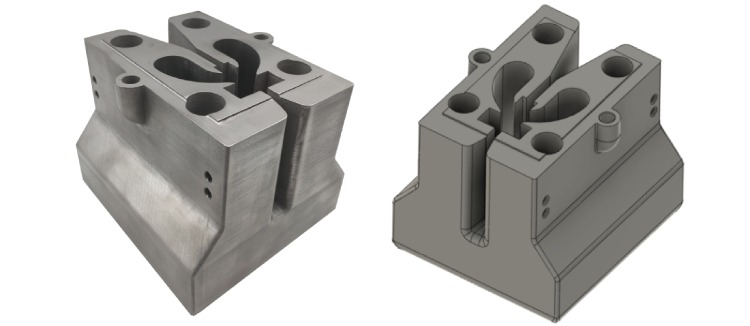3D PRINTING MATERIALS
Aluminium - AlSi10Mg
ALUMINIUM AlSi10Mg
Features of 3D printed AlSi10Mg Aluminum

The aluminum alloy AlSi10Mg used in additive manufacturing is an excellent combination between lightness, solidity and price level.
While inexpensive, aluminum provides good mechanical and thermal properties. However, it is less resistant to fatigue and high temperatures than Stainless Steel for example.
It is used to manufacture prototypes, finished products or parts and production tools.
The AlSi10Mg-0403 alloy includes aluminum alloyed with silicon, small amounts of magnesium and iron, as well as other minor elements.
The presence of silicon makes the alloy both harder and more resistant than pure aluminum.
Thanks to the natural formation of an oxide layer on the surface of the aluminum alloy, the material has a high resistance to corrosion which can be further improved by chemical anodization.
Example of areas of application of Aluminum AlSi10Mg:
Industries that require light parts such as the automotive or aeronautical sector.
Production of components with complex shapes such as internal channels or very thin walls.
Material properties of Aluminum Aisi 10mg by additive manufacturing
| Valeurs | |
| Densité | 2.68 g/cm³ |
| Conductivité thermique | 130 W/mK à 190 W/mK |
| Niveau de fusion | 570 °C to 590 °C |
| Conditions Méthodes |
Valeurs | |
| Force de tension | Test ASTM E8 |
Horizontal 334 MPa ±1 MPa Vertical 339 MPa ±6 MPa |
| Élasticité | Test ASTM E8 |
Horizontal 211 MPa ±2 MPa Vertical 174 MPa ±4 MPa |
| Allongement à la rupture | Test ASTM E8 |
Horizontal 9% ± 2% Vertical 4% ±1% |
| Module d’élasticité | Test ASTM E8 |
Horizontal 71 GPa ±2 GPa Vertical 66 GPa ±3 GP |
| Dureté (Vickers) | ASTM E384-1 |
Horizontal 103 HV0.5 ±5 HV0.5 Vertical 98 HV0.5 ±5 HV0.5 |
| Rugosité de surface (Ra) | JIS B 0601-2001 (ISO 97) |
Horizontal 5 μm to 9 μm Vertical 7 μm to 9 μm |
| Dureté Shore D | 84 | |
| Coefficient d’expansion thermique | ASTM E831-93 <35°C >60°C |
70 μm/m-°C 160 μm/m-°C |
| Transition vitreuse (Tg) | DMA, E’’ | 56°C |
 FRA
FRA ESP
ESP ENG
ENG